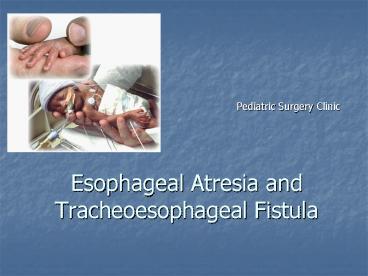Esophageal Atresia and Tracheoesophageal Fistula - PowerPoint PPT Presentation
1 / 28
Title:
Esophageal Atresia and Tracheoesophageal Fistula
Description:
(A) The laryngotracheal diverticulum forms ... The chest radiograph. A plain radiograph will confirm the tube has not reached the stomach ... A plain radiograph ... – PowerPoint PPT presentation
Number of Views:3892
Avg rating:3.0/5.0
Title: Esophageal Atresia and Tracheoesophageal Fistula
1
Esophageal Atresia and Tracheoesophageal Fistula
- Pediatric Surgery Clinic
2
Successive stages in the development of the
tracheoesophageal septum during embryologic
development.
- (A) The laryngotracheal diverticulum forms as a
ventral outpouching from the caudal part of the
primitive pharynx. - (B) Longitudinal tracheoesophageal folds begin to
fuse toward the midline to eventually form the
tracheoesophageal septum. - (C) The tracheoesophageal septum has completely
formed. - (D) If the tracheoesophageal septum deviates
posteriorly, esophageal atresia with a
tracheoesophageal fistula develops
3
Esophageal atresia is a congenital abnormality in
which the midportion of the esophagus is absent.
- Incidence is between 1 in 3,570 and
- 1 in 4,500.
4
Anatomic Variations
- 85
- Most common
- VOGTtype3(b)
- GROSS type C
5
Anatomic Variations
- 6
- Atresia alone,
- no fistula
- Small stomach,
- gasless abdomen
- Usually has a long
- gap between the
- esophagealends
- VOGT types 1 and 2
- GROSS type A
6
Anatomic Variations
- 2
- Proximal tracheo-
- esophageal fistula
- No distal fistula
- Small stomach,
- gasless abdomen
- Often has a long
- gap between the
- esophagealends
- VOGT type 3(a)
- GROSS type B
7
Anatomic Variations
- l
- Proximal and
- distal fistulas
- ("double fistula")
- VOGT type 3(c)
- GROSS type D
8
Anatomic Variations
- 6
- No atresia of
- the esophagus
- Congenital
- tracheoesophageal
- fistula
- "H" or "N" fistula
- GROSS type E
9
Physiologic effects of distal tracheoesophageal
fistula
- 1. Hyaline membrane disease may necessitate
higher ventilator pressures, which encourage air
to pass through the distal fistula. - 2. A distended abdomen elevates and "splints" the
diaphragm. - 3. Gastric distension may result in gastric
rupture and pneumoperitoneum. - 4. Passage of air through a distal
tracheoesophageal fistula diminishes the
effective tidal volume. - . (B) 1. Aspiration of gastric juices leads to
soiling of the lungs and pneumonia - 2. Gastroesophageal reflux
- 3. Direction of gastric fluid proximally through
distal fistula. - 4. Overflow of secretions or inadvertent feeding
may contribute to aspiration and contamination of
the airway. .
10
Associated Abnormalities
- Incidence of Associated Anomalies in Esophageal
Atresia. - Anomaly
Frequency () - Congenital heart disease
25 - Urinary tract
22 - Orthopaedic (mostly vertebral and radial)
15 - Gastrointestinal (e.g., duodenal
- atresia,imperforate anus)
22 - Chromosomal (usually trisomy 18 or 21)
7 - Total with one or more associated
58 - anomalies
11
Associated Congenital Anomalies Reported in
Patients with Esophageal Atresia
12
DIAGNOSIS OF ESOPHAGEAL ATRESIA
- Antenatal Diagnosis (maternal polyhydramnios, a
small stomach, a distended upper esophageal
pouch, or abnormal swallowing) - Diagnostic suspicion is increased when
abnormalities known to be associated with
esophageal atresia are identified.
13
Fetal MRI
- This 32 week fetus had esophageal atresia and an
absent stomach, resulting in marked
polyhydramnios
14
Clinical Diagnosis
- Prematurity
- Any excessively drooling (copious, fine, white,
frothy bubbles of mucus in the mouth and,
sometimes, the nose).
15
Clinical Diagnosis
- . (A) Diagnosis of esophageal atresia is
confirmed when a 10-gauge (French) catheter
cannot be passed beyond 10 cm from the gums. (B)
A smaller-caliber tube is not used because it may
curl up in the upper esophageal segment, giving a
false impression of esophageal continuity.
16
The chest radiograph
- A plain radiograph will confirm the tube has not
reached the stomach
17
The Gasless Abdomen
- Absence of gas in the abdomen suggests that the
patient has either atresia without a fistula or
atresia with a proximal fistula only
18
Contrast studies
- should be performed by an experienced pediatric
radiologist, or after transfer to the tertiary
institution, and with the use of a small amount
(0.5 to 1 mL) of water-soluble contrast. Care
must be taken to avoid aspiration.
19
Management
- Measures should be taken to reduce the risk of
aspiration(continuous suctioning of the upper
pouch, the infant's head should be elevated). - In infants with respiratory failure, endotracheal
intubation should be performed. - Transfer to a major tertiary pediatric
institution is best not delayed .
20
Summary of Preoperative Investigations
- A plain radiograph
- Renal ultrasonography and echocardiography are
routine preoperative investigations - Endoscopy or a careful midesophageal contrast
study performed in a tertiary center. In some
centers, bronchoscopy is performed routinely in
all infants with esophageal atresia.
21
Operative Repair of Esophageal Atresia
- Surgical repair is delayed (1-2days) in infants
with low birth weight, pneumonia or other major
anomalies.
22
Operative Repair of Esophageal Atresia
23
Operative Repair of Esophageal Atresia
24
Tracheoesophageal fistula without atresia (type
E).
- Respiratory difficulty after feedings in a
3-day-old boy. Barium esophagogram clearly shows
an H-shaped fistula between the trachea and the
middle segment of the esophagus (arrowhead).
Barium is filling the bronchi of the right lower
lobe (arrows).
25
Tracheoesophageal fistula without atresia (type
E).
- Esophagogram shows a fistula (arrow) arising from
the anterior portion of the esophagus (e) and
passing cephalad to the posterior portion of the
trachea (t).
26
Tracheoesophageal fistula without atresia (type
E).
- Endoscopic diagnosis
27
Congenital tracheoesophageal fistula
28
The end































